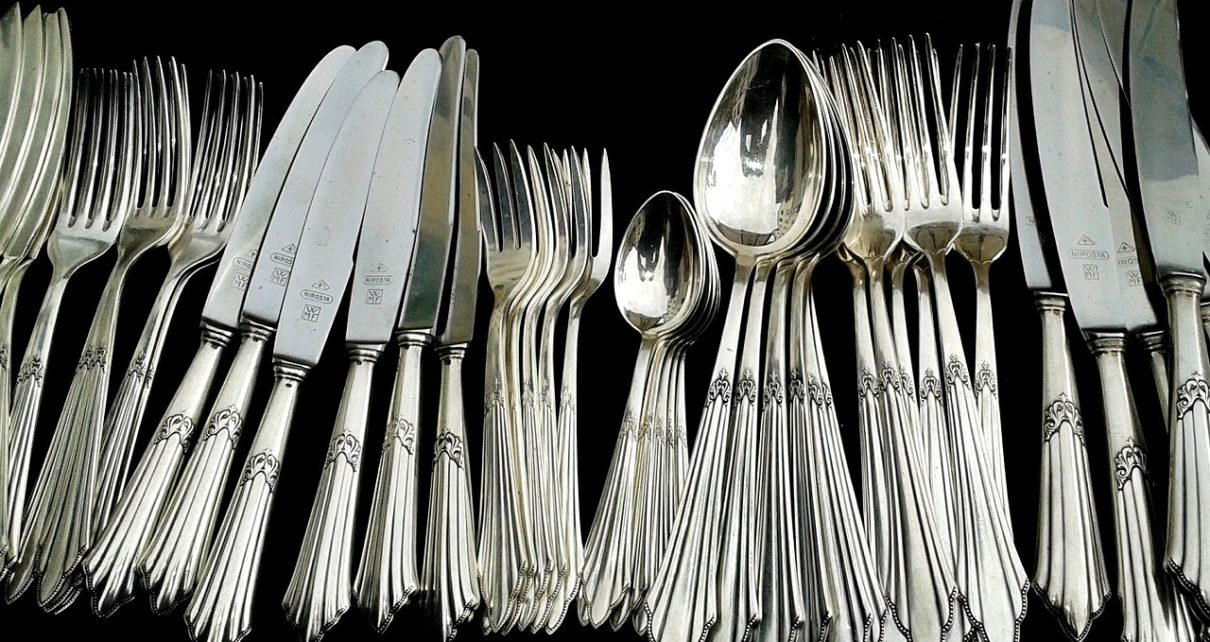An Introduction
The rules that specify how knife, fork, and spoon must be used have evolved along with the forms of the utensils themselves. In general, these rules are explicitly intended to prevent the utensils from appearing threatening.
Margaret Visser, in her book The Rituals of Dinner, points out that etiquette and the ritual it imposes helps to control the violence inherent in the preparation and serving of meals. Animals are slaughtered and consumed, the guest-host relationship is, in itself, a complicated interweaving of the imposition of obligation and suspension of hostility, and the ordinary table knife is related to actual weapons of war.
Consequently, flatware is held delicately, carefully balanced on the prescribed fingers and guided by the fingertips. To hold any utensil in a fist or to manipulate it in such a way that is pointed at anyone would hint at potential danger, as would even setting it down in an inappropriate way.
Holding a Utensil
In general use, both spoon and fork are held horizontally by balancing them between the first knuckle of the middle finger and the tip of the index finger while the thumb steadies the handle. The knife is used with the tip of the index finger gently pressing out over the top of the blade to guide as you cut.
The Zig Zag Method
By American custom, which was brought about partly by the late introduction of the fork into the culture, all three utensils are intended for use primarily with the right hand, which is the more capable hand for most people.
This leads to some complicated maneuvering when foods, such as meat, require the use of knife and fork to obtain a bite of manageable size. When this is the case, the fork is held in the left hand, turned so that the tines point downward, the better to hold the meat in place while the right hand operates the knife.
After a bite-sized piece has been cut, the diner sets the knife down on the plate and transfers the fork to the right hand, so that it can be used to carry the newly cut morsel to the mouth. Emily Post calls this the “zig-zag” style.
European Style
The European, or “Continental,” style of using knife and fork is somewhat more efficient, and its practice is also common in the United States, where left-handed children are no longer forced to learn to wield a fork with their right hands. According to this method, the fork is held continuously in the left hand and used for eating. When food must be cut, the fork is used exactly as in the American style, except that once the bite has been separated from the whole, it is conveyed directly to the mouth on the downward-facing fork. Regardless of which style is used to operate fork and knife, it is important never to cut more than one or two bites at one time.
Peas!
Another significant difference between the American and the Continental styles of using knife and fork is the American insistence that even the most awkward and contrary foods (peas being the traditional example) must be captured by the unaided fork. In Europe it is permitted to use the knife or a small bit of bread to ease a stubborn item onto the fork.
Once-Used Placement
There are numerous rules and prohibitions regarding the proper placement of eating utensils once they have been used. Essentially, used flatware must never be allowed to touch the surface of the table, where it might dirty the cloth. It is not proper to allow even the clean handle of a knife or fork to rest on the cloth while the other end lies on the plate. At the end of a course, a utensil must not be left in any dish that is not flat — the soup bowl, for example, or a shrimp cocktail dish, a teacup or a parfait glass. All these items are usually presented with a plate underneath the bowl or cup, on which the utensil must be placed after use.
Placement in General
The positioning of knife and fork when not in use acts as a sort of semaphore, allowing the diner to indicate the degree to which he intends to pause in eating. Flatware should always be placed on the plate during pauses between bites. If this is to be a very short time, there is no set pattern. For longer waits, perhaps caused by a diverting twist in the table conversation, the diner places the fork on the left and knife on the right, so that they cross over the center of the plate.
The diner preparing to pass his plate for a second helping places the fork and knife parallel to each other at the right side of the plate, so that there is room for the food. When the diner has finished, he signals this by setting the fork and knife parallel to each other, so they lie either horizontally across the center of the plate or are on the diagonal, with the handles pointing to the right. The cutting edge of the knife blade should face toward the diner (again, avoiding all possible aggressive implications), and the fork may be placed with the tines either up or down.

its harder than i thought🙄🤔
Table manners,Its harder than i thought.🙄🤔
OMG